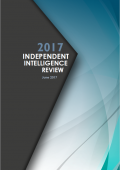 There’s an air of ‘continuity with change’ about the new Independent Intelligence Review. The review almost flew under the radar this week amid all of the other changes to Australia’s national security apparatus. This post is my initial reflection on the review’s main recommendations.
There’s an air of ‘continuity with change’ about the new Independent Intelligence Review. The review almost flew under the radar this week amid all of the other changes to Australia’s national security apparatus. This post is my initial reflection on the review’s main recommendations.
As for continuity, it’s clear that the reviewers, Michael L’Estrange and Stephen Merchant, found most of the existing arrangements to be fit for purpose: ‘The clear dividing lines [that Justice Hope’s royal commissions of the 1970s and ’80s] highlighted—between foreign and security intelligence, intelligence and law enforcement, intelligence collection and assessment, and intelligence assessment and policy formulation—continue to provide the foundations of Australia’s intelligence community. We assess those delineations have broad enduring relevance.’
Following that assessment, it’s perhaps a little surprising that one of the major recommended changes was the establishment of a new Office of National Intelligence, to be located in the prime minister’s portfolio. While that would bring Australia’s intelligence arrangements into line with the other Five Eyes partners (Canada, New Zealand, the UK and the US), the need for the new office isn’t immediately clear. Under the existing arrangements there’s already a statutory responsibility on the Office of National Assessments to play a coordination role. Section 5 of the ONA Act says that one of the functions of the office is ‘to coordinate the foreign intelligence activities that Australia engages in, including in relation to setting Australia’s foreign intelligence requirements based on Australia’s foreign intelligence priorities’.
So the coordination mechanism is already in place, at least as far as foreign intelligence activities are concerned, and it has been running smoothly for many years. But the review observes that the contemporary threat environment is increasingly transnational in nature, and that there’s more overlap between foreign and domestic intelligence requirements than hitherto, especially in the area of counterterrorism. The argument for the new ONI to have a wider remit than ONA (which it will subsume) seems to come down to a tighter integration of foreign and domestic security intelligence.
I’m not entirely convinced by that argument, for two reasons. First, as ASIO will tell anyone within earshot, it is emphatically not a ‘domestic spy agency’. Its work has had an international aspect for as long as the agency has existed, and it seems to have managed perfectly well. Second, the multi-disciplinary National Threat Assessment Centre was stood up in 2003, and has been a demonstrable success in coordinating domestic and foreign intelligence activities and law enforcement. The centre’s work has been behind many of the successful disruptions of planned terrorist acts.
The other thing that puzzled me on my first reading was the recommended change of status of the Australian Signals Directorate, the national signals intelligence and information security agency. ASD has long resided in the Department of Defence for management purposes, as befits its important role in supporting military operations. But it has also had another hat as a national agency and information security authority. The review recommends putting the emphasis more on the ‘national’ role and making ASD a statutory body, though (confusingly) it will remain in the Defence portfolio. But ASD will no longer be subject to the ‘efficiency dividends’ (an Orwellian term for budget cuts) that other agencies in the portfolio have to absorb.
Freeing ASD from the efficiency dividend is a worthwhile step. The demand for its services has increased sharply in recent years, mostly because of the increasing importance of its defensive and offensive cyber activities, as well as its terrorism-related work. From discussions, it’s clear that ASD has suffered badly from the dual pressures of less money—and hence fewer staff—and more demand. It has also suffered when trying to recruit IT-savvy personnel for its cyber arm, and four years of zero wage growth made an already difficult situation worse. But surely the government could simply have instructed the previous Defence secretary to allocate ASD an appropriate budget? It’s hard to avoid the conclusion that this is another piece of evidence that Russell Hill has largely been an ungoverned fiefdom in recent years.
In any case, there’ll need to be a substantial rewrite of the corresponding legislative framework. Since 2001, the activities of ASD and the two other foreign intelligence collection agencies (the Australian Secret Intelligence Service and the Australian Geospatial-Intelligence Organisation) have been regulated by the Intelligence Services Act. With ASD becoming a statutory body, it will presumably require its own Act, which might be a good thing in some ways. While ASD’s signals intelligence function plays the same broad security role as the human and geospatial intelligence activities of ASIS and AGO, respectively, its cyber activities are distinctly different. A tailored legal framework will be helpful as cyber operations mature. An alternative approach might have been to split off signals intelligence from cyber, but that also has pros and cons—which the US has been grappling with.
On balance then—and I stress that this is based on my first reading of the report—the major changes that have been announced don’t seem to be aimed at solving obvious problems. (That could also be said of all of this week’s announcements.) But they also result in new arrangements that, if carefully implemented, could build on existing strengths. Hopefully the working parts of the existing model will undergo minimalist changes.
One thing I haven’t mentioned in this post is the oversight of intelligence. I’ll come back to that next week.

